Health Benefits of Red Light Therapy: Legit or Hype?
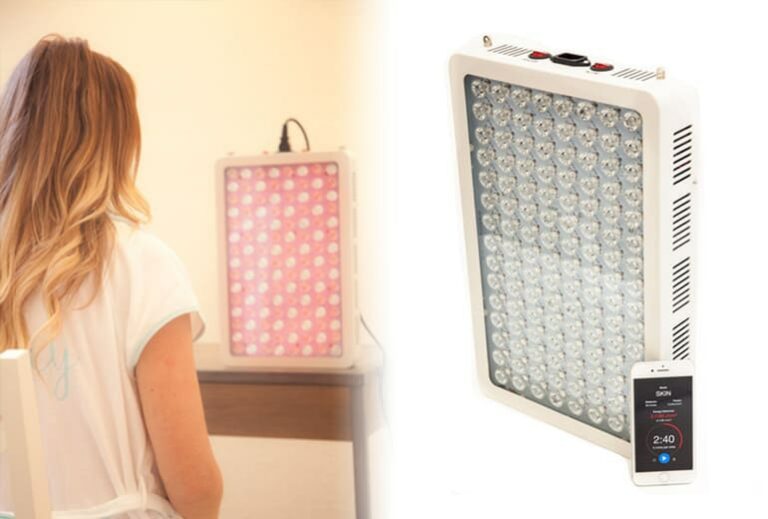
Did you know that light is actually a nutrient, and your longevity and health depend on it?
You’ll want to read this post since, for the first time in history, many people in the modern world are rarely exposed to the healing rays of the sun!
A fantastic book by my friend and colleague Ari Whitten covers over 3,000 published studies about red and near-infrared light and its benefits to human health.
Luckily, even if you live in a place where you cannot be in the sunshine every day like hominids have for millennia, you can replace these deficits in your nutrition (yes, nutrition!) and potentially correct health problems – with simple means.
[I believe red and near infrared light may be the most powerful, overlooked nutrient of our time. Want to learn what I've discovered after years of experimenting with light therapy? Join here to watch my new class – it's free!]
In this article:
- The History of Light as a Healing Modality
- Light Deficiency and Longevity
- Why Red Light Therapy?
- How Does Red Light Therapy Work?
- Top 11 Red Light Therapy Health Benefits
- Red Light Therapy & FDA Approval
- How to Get the Benefits of Red and NIR Light Therapy
- How to Identify Quality Red Light Therapy for Home Use
- My Experience with Red Light Therapy
- How Long Should a Red Light Therapy Be? Can You Overdose?
- To Sum it Up
- Sources
The History of Light as a Healing Modality
Phototherapy (the use of light for therapeutic purposes) has been a recognized healing treatment since at least 1400 BCE in India, when people with patchy depigmentation of the skin, thought to be a form of leprosy, were given plant extracts to eat before being exposed to the sun.
In the more recent past, 18th-century doctors reported treating various diseases with sunlight, including destroying tumors and accelerating the healing of wounds by applying sunlight concentrated through a lens.¹
From there, the list of diseases treated with light expanded, from physicians treating lupus and smallpox to NASA using it to help astronauts in space maintain bone and muscle mass, and even to treat chronic wounds.

Red light therapy is just one of many healing modalities that use the power of light.
Since the 1980s, the most commonly-recognized use for light therapy is for depression and sleep disorders. This treatment is so well accepted that home-use “light boxes” are in millions of households, combating symptoms of Seasonal Affective Disorder with sunlight-mimicking rays.
It’s clear that most of our ancestors rose with the sun and, though avoiding strong, direct exposure when they could, spent much of their day in and out of the sun’s rays.
In today’s modern world, we, on the other hand, live under the fluorescent lights found in offices, restaurants, a myriad of businesses, and our homes.
[Related: The Healing Power of the Sun + 5 Effective Natural Sunburn Treatments]
Light Deficiency and Longevity
Sunlight is so essential to health that modern research shows even our lifespan can depend on it.
A Swedish study conducted over two decades on 30,000 women revealed that those who spent more time in the sun over the span of 20 years lived longer and had less heart disease. In fact, women with the lowest sun exposure had a two-fold higher death rate than those with the most sun exposure!²
Another study compared the lifespan of scientists that worked indoors to those that worked outside. The data revealed that the average age that scientists die is “appreciably higher” for those scientists who work outdoors.³

Working outdoors in sunlight exposure is correlated with longer lifespan.
Unfortunately, the world we live in today does not offer everyone the opportunity to work outdoors. In fact, according to the Environmental Protection Agency (EPA), the average American spends 93% of their life indoors!4
So, how do we obtain the benefits of the sun while we live under artificial lights?
Enter the phenomenon known as red light and near-infrared light therapy. Before we take a look at its many healing attributes, let’s look at what makes it so special compared to other light sources.
Why Red Light Therapy?
As with any other living creature, our cells need light to survive.
To be more specific, we require red and near-infrared (NIR) light waves (which lie next to each other on the light spectrum) to function optimally.
When you spend time in the sun or sitting around a fire at day’s end, you are soaking up this segment of the light spectrum.
These two wavelengths can penetrate deep into our tissues—in some instances, as deep as two inches, where they find their way into our cells, tissues, bones, brain, and blood. And there, the healing begins.
How Does Red Light Therapy Work?
When red and NIR light penetrates our cells, they activate the mitochondria. These organelles float freely within our cells and are known as the cell’s powerhouse.
Mitochondria produce adenosine tri-phosphate (ATP)—the universal energy supplier that keeps our cells functioning. When you breathe, eat, walk, and even sleep, your cells are using ATP.
In cells that require massive energy, such as those found in your muscles, there can be thousands of mitochondria in just one cell.
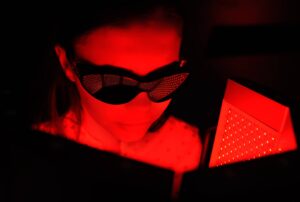
Red light therapy assists individual cells and helps fight inflammation.
In addition to stimulating ATP production in the mitochondria, red light is involved in a phenomenon known as hormesis.
It creates a temporary, low-dose metabolic stress by promoting a low-level inflammatory response and an increase in free radicals. This stress causes the body to activate its defense system, which will attack the free radicals and resolve the inflammation.
(You may have the idea that stress is always bad. While chronic, high-dose “eustress” is proven to be bad for the human organism, hormesis is achieved through exercise, muscle-building activities, sauna use, and many other processes that are highly beneficial for the body.)
Because of these properties, red and NIR light have been found to possess amazing healing potential.
My friend Ari Whitten, an energy and fatigue specialist, lists over 23 effects these types of lights have on the human body, as documented in recent scientific literature, in his book, The Ultimate Guide to Red Light Therapy.5
Top 11 Red Light Therapy Health Benefits
Here are what I consider the most remarkable health benefits of red and NIR light:
1. Supports weight loss as well as fat and cellulite reduction.
Numerous studies have reported the loss of several inches from participant’s hips and waists through the use of red and NIR light therapy. Other studies support its reducing effects on cellulose.6,7
While the exact mechanism is unclear, it appears that this type of light stimulates blood circulation by triggering the production of nitric oxide, a vasodilator, and causes fat cells to release their fatty acids back into the bloodstream where it can be burned for fuel.
Red and NIR light therapy has also been shown to stimulate the production of collagen and elastin, two major proteins found throughout the body that are responsible for the strength and elasticity of our skin and tissues. Cellulite is caused not only by excess fat but also by unhealthy collagen and elastin.
Remarkably, when combined with massage, red light therapy resulted in a 71% reduction in cellulite!8
[Related: 10 Green Smoothie Recipes for Weight Loss and Fat Burning]
2. Reduces the signs of aging, such as wrinkles and skin discoloration.
While I believe that eating a healthy, mostly or all plant-based diet and including physical activity in our daily lives is the ultimate anti-aging plan, the years have a way of aging the look of our skin despite a healthy lifestyle.
Reducing these signs of aging through red and NIR light therapy is so much better than the unhealthy alternatives of Botox and facelifts!
Red light’s ability to stimulate the production of collagen and reduce inflammation makes this therapy a potent contender in helping us maintain youthful skin.
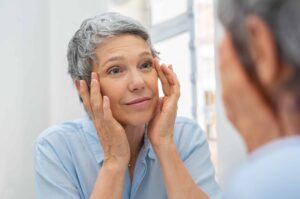
If you're concerned about wrinkles and other signs of aging on the skin, red light therapy can help.
A study reported in the Journal of Physical Therapy Science found a significant reduction in wrinkles around the eyes as well as an increase in skin moisture through the use of low-level light therapy.9
[Related: 7 Key Nutrition Factors for Youthful Beauty You Will Love]
3. Combats fibromyalgia and chronic fatigue.
The latest research in fibromyalgia and chronic fatigue suggest that these two conditions are caused, in part, by mitochondrial dysfunction and an increase in inflammation that occurs in both the body and brain.
Because of red light’s anti-inflammatory effects as well as stimulating the production of ATP, it is a potent qualifier as a therapy that both increases energy and reduces pain.
One study on patients suffering from the effects of fibromyalgia found a remarkable reduction in pain, muscle spasms, morning stiffness, and the number of total tender points after treatments with low-level laser therapy.10
[Related: No Energy? Fatigue Causes You Haven’t Considered But Must Address NOW]
4. Improves cognitive performance.
Our brains use more energy than any of our other organs—accounting for up to 20%. MRI scans prove that NIR light photons penetrate the skull, increasing the blood flow to the brain as well as spurring the mitochondria to produce more ATP.
The result is that we possess more clarity and sharper thinking skills.
Even patients with traumatic brain injuries and PTSD (post-traumatic stress disorder) have benefited from light therapy. One study found patients with chronic brain injuries showed gains in verbal learning, memory, better sleep, and fewer PTSD symptoms following red and NIF light therapy. 11
5. Reduces depression and anxiety.
Light therapy has been used for seasonal depression for decades. I know I certainly feel better after spending time in the sun’s warming rays (sunlight does contain red and NIR lightwaves). But can concentrated red light have an affect on those that suffer from year-round anxiety and depression?
A recent metastudy suggests so. When researchers reviewed all existing studies on the treatment of depression and anxiety with red and NIR light therapy, they found it to be a “promising” treatment for major depression, anxiety, and traumatic brain disorder. 12
Note: Red light therapy is a concentrated form meant to induce specific therapeutic reactions. It is not the same as a "light box" type sunlamp meant to replicate sunlight.
[Related: How To Fight Depression and Anxiety: 12 Nutrition Strategies]
6. Improves eye health.
Age-related macular degeneration (AMD) is the number one cause of vision loss in the U.S.
It is a disease that affects more Americans than cataracts and glaucoma combined, and one that, ultimately, destroys the central vision. Currently, it is considered an incurable disease.

Red light therapy has been shown to benefit eye health.
When 203 patients with AMD were treated with low-level light therapy, 95 percent showed significant improvement in visual acuity. Their improved vision lasted anywhere from 3 months to 3 years following treatment.13
7. Improves oral health.
Numerous studies have proven the positive impact that red and NIR light therapy have on the health of our teeth, gums, and surrounding tissues.14,15
A few of these benefits include the ability to fight infections, reduce pain, reduce thrush (an infection caused by an overgrowth of Candida yeast), and improve tooth sensitivity. It also speeds up healing following dental procedures!
8. Improves thyroid function.
An estimated 20 million Americans have some form of thyroid disease. What’s even more startling is that approximately 60% of these people do not know that they have thyroid issues yet, though they are struggling with symptoms.
And yet, our thyroid is a major player in our health--regulating our many body functions by continuously releasing a steady stream of thyroid hormones into the bloodstream. Thyroid imbalance creates symptoms such as fatigue, depression, memory loss, anxiety, insomnia, and weight gain.
Conventional treatments usually consist of lifelong prescribed medications that come with several side effects.
The good news? Clinical research is showing that NIR light therapy is a natural treatment for thyroid conditions. When patients with a hypothyroid caused by chronic autoimmune thyroiditis received NIR light therapy, 47% of them were able to stop taking their thyroid medication completely.16

Thyroid issues are common, but they can be reduced or resolved through red light therapy.
9. Slow hair loss and promote hair growth.
There are numerous causes of hair loss, from thyroid problems to medications and emotional stress. While people take hair loss in stride, others, particularly women, can find it wreaking havoc on their self-image.
It’s surprising to note that 40 percent of women over the age of 40 have visible hair loss.
Red and NIR light therapy have been shown to both regrow and thicken hair in several studies.17,18
10. Combats inflammation.
Chronic inflammation has been linked to nearly every disease, from cancer to heart disease, Alzheimer’s, arthritis, asthma, depression, and even obesity.
Inflammation can arise from an infection, an autoimmune disorder, or long-term exposure to chemicals and pollutants. Lifestyle choices play a strong part in contributing to this very common condition.
As we discussed, red and NIR light have an anti-inflammatory effect on the human body. Michael Hamblin, a Harvard researcher who is considered an expert in the field of red light therapy, has done extensive research on the many mechanisms by which this type of therapy reduces inflammation in several chronic conditions, including arthritis, inflammatory pain, and lung inflammation.19
Red light therapy may offer significant hope for many of today’s “modern” diseases and further studies are ongoing as red and NIF light therapy becomes mainstream.
11. Combats acne bacteria and inflammation.
Because of the ability of red light to reduce inflammation while increasing blood flow, this type of therapy is commonly used to treat acne.
Hooman Khorasani, the Chief of the Division of Dermatological and Cosmetic Surgery at the Icahn School of Medicine at Mount Sinai, suggests the use of both blue and red light therapy which destroy acne-causing bacteria while reducing the size of the sebaceous glands and thereby reducing oil.20
The bottom line: Our mitochondria provide 90 percent of the energy that fuels cellular activity and keeps us alive. When we boost our ATP production at this cellular level, we boost our energy at a physical level.
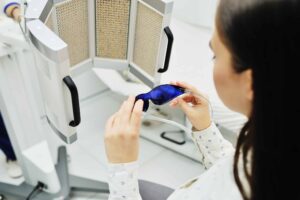
Red light therapy offers diverse health benefits and has received FDA approval.
Red Light Therapy & FDA Approval
The amazing aspect of all of this research is that more people aren’t shouting out the benefits of red light therapy!
Even the FDA—the strict government regulator—has approved red and NIR light therapy for anti-aging, hair-loss reversal, pain relief, acne treatments, healing wounds, and fat loss.
How to Get the Benefits of Red and NIR Light Therapy
There was a time when you had to obtain any type of phototherapy at your doctor’s office. Coined “low-level laser therapy” (LLLT), these medical devices cost anywhere from $3,000 to $30,000.
The other alternative was to go to anti-aging clinics where, for $75 to $300, you could buy a single session beneath red and NIR light panels.
For many people, these two options priced them out of this remarkable therapy.
The good news is that you no longer need a medical laser device or a trip to expensive clinics to obtain the benefits of red and NIR light therapy. Now, you can do light sessions at home.
How To Identify Quality Red Light Therapy For Home Use
One warning: As red light therapy becomes increasingly mainstream, some attempt to exploit its popularity. Consequently, cheap and ineffective “red light therapy” devices are starting to flood the market.
Fortunately, there are specific requirements to look for. Ari Whitten breaks it down into five variables.5 These include:
- Wavelength—Look for wavelengths in the therapeutic range of 630 to 680nm (red light range) and/or 800 to 880nm (NIR range). Ideally, the device will offer both of these ranges.
- Power Density—Look for a power density of at least 30mW/cm² (2 to 3-feet away), and around 100mW/cm² from close range which is about 6 inches away.
- Size of Light—According to Whitten, a device with a high-power output that also treats a large area at once is where the magic happens. A large panel light is highly recommended over a hand-held device.
- Warranty—Make sure you’re purchasing a product that the manufacturer stands behind.
- Purpose—These different wavelengths offer different therapeutic benefits. Red light does not penetrate as deep as NIF, making it better suited for anti-aging and topical treatments. NIR, on the other hand, penetrates deeper which is better suited for internal therapy targeted at the brain, muscles, and organs.

Do your research before buying a red light therapy machine for home use.
My Experience With Red Light Therapy
My family and I have personally been using the devices from Red Light Therapy Co.
Here are the benefits we noticed after using these units for 6 months:
- Record-quick healing from inflammation from our sports injuries (and my swollen joint in one hand, from working at the computer 60 hours a week for a few weeks)
- Better energy during the day and sleep during the night
- Faster hair growth,
- And better sexual stamina and performance.
The Red Rush is also extremely low in energetic pollution output, or EMF, according to Ari Whitten’s research.
If you already possess a different therapeutic light, don’t despair!
Though it may not be the “best in class,” obtaining some of the benefits associated with red and NIR light therapy is much better than getting none of the benefits – you are one of the early adopters and likely getting some great benefits!
If you have not purchased your therapeutic light just yet, consider the important differences and choose accordingly.
The key to effectively using this red-light therapy is daily use for 12 - 24 weeks, for 10 minutes a day.
How Long Should A Red Light Therapy Session Be? Can You Overdose?
As with many things in life, moderation is key.
You can overdose on red light therapy. In fact, getting too much light can negate the benefits.
Start slow, a few sessions per week, and work your way up to one session a day, for the devices by Red Light Therapy Co.
The time (length of a session) and distance (light from your body) varies depending on the intent of the treatment and the manufacturer.
Generally, the light should be about 6” to 36” away from the body – up to 12” for deep tissue treatments and 12” to 36” for skin issues.5
I recommend purchasing Ari Whitten’s book, which details the appropriate body distance for various uses. However, each company’s instructions will tell you the basics.
To Sum it Up
There are over 3,000 scientific studies demonstrating the health and anti-aging benefits of red and NIR light therapy.
These include the following:
- Increases fat loss
- Decreases pain
- Speeds up healing of wounds and injuries
- Increases energy
- Combats fibromyalgia and chronic fatigue
- Combats hair loss
- Reduces inflammation
- Has anti-aging effects
- Supports healthy eyes, teeth and gums
- Increases strength, endurance and muscle mass
Red light isn’t a “miracle cure,” but it’s one more tool you can put in your arsenal for health and wellness.
It’s the nutrient every cell needs and one that, in our modern times, we get very little of – light.

Disclosure: This post may contain affiliate links that help support the GSG mission without costing you extra. I recommend only companies and products that I use myself.
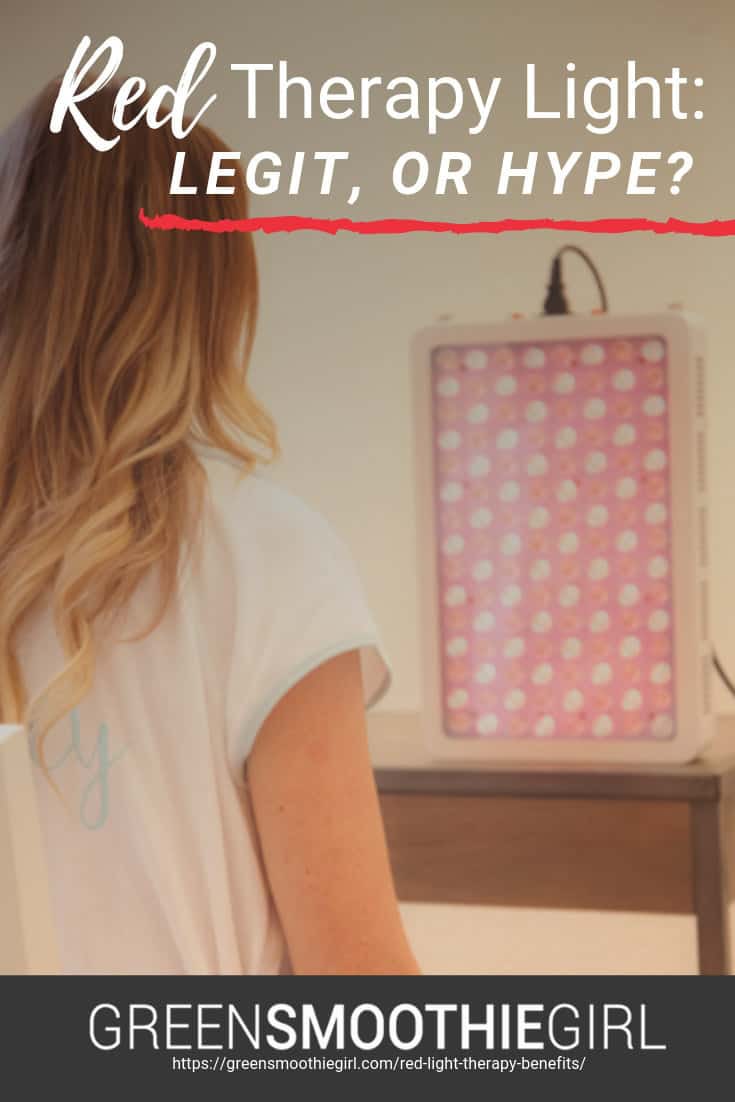
Resources
1. Hamblin, Michael R. & Huang, Yingying. Handbook of Photomedicine. Taylor & Francis. 2014.
2. Lindgvist, PG et al. Avoidance of sun exposure as a risk factor for major causes of death: a competing risk analysis of the Melanoma in Southern Sweden cohort. Journal of Internal Medicine. 10/2016. https://www.ncbi.nlm.nih.gov/pubmed/26992108
3. Luria, S.M. Average Age at Death of Scientists in Various Specialties. Bureau of Medicine and Surgery, Navy Department Research Work Unit. 01/1970. https://apps.dtic.mil/sti/tr/pdf/AD0706360.pdf
4. Klepeis, Neil et al. The National Human Activity Pattern Survey (NHAPS): a resource for assessing exposure to environmental pollutants. 07/2001. https://www.nature.com/articles/7500165
5. Whitten, Ari. The Ultimate Guide to Red Light Therapy. Archangel Ink. 2018.
6. Montazeri, Katayoon et al. The Effect of Combination of Red, Infrared and Blue Wavelengths of Low-Level Laser on Reduction of Abdominal Girth: A Before-After Case Series. The Journal of Lasers in Medical Sciences. 08/2017. https://www.ncbi.nlm.nih.gov/pmc/articles/PMC5642174/
7. Avci, Pinar M.D. et al. Low-Level Laser Therapy for Fat Layer Reduction: A Comprehensive Review. Lasers in Surgery and Medicine. 08/2013. https://www.ncbi.nlm.nih.gov/pmc/articles/PMC3769994/
8. Gold, MH. et al. Reduction in thigh circumference and improvement in the appearance of cellulite with dual-wavelength low-level laser energy and massage. Journal of Cosmetic and Laser Therapy. 02/2013. https://www.ncbi.nlm.nih.gov/pubmed/21275531
9. Kim, Hee-Kyoung et al. Effects of radiofrequency, electroacupuncture, and low-level laser therapy on the wrinkles and moisture content of the forehead, eyes, and cheek. Journal of Physical Therapy Science. 02/2017. https://www.ncbi.nlm.nih.gov/pmc/articles/PMC5332991/
10. Gur, A. et al. Efficacy of low power laser therapy in fibromyalgia: a single-blind, placebo-controlled trial. Lasers in Medical Science. 01/2017. https://www.ncbi.nlm.nih.gov/pubmed/11845369
11. Can Light Therapy Help the Brain? VA Research Currents. 03/2015. https://www.research.va.gov/currents/spring2015/spring2015-7.cfm
12. Cassano, Paolo et al. Review of transcranial photobiomodulation for major depressive disorder: targeting brain metabolism, inflammation, oxidative stress, and neurogenesis. Neurophotonics. 07/2016. https://www.ncbi.nlm.nih.gov/pmc/articles/PMC4777909/
13. Ivandic, BT et al. Low-level laser therapy improves vision in patients with age-related macular degeneration. Photomedicine and Laser Surgery. 06/2008. https://www.ncbi.nlm.nih.gov/pubmed/18588438
14. Vieru, Dana et al. Low- Level Laser Therapy in the Treatment of Periodontal Disease. Laser Therapy. 11/2007. https://www.jstage.jst.go.jp/article/islsm/16/4/16_4_199/_article
15. Maver-Biscanin M et al. Effect of low-level laser therapy on Candida albicans growth in patients with denture stomatitis. Photomedical Laser Surgery. 06/2005. https://www.ncbi.nlm.nih.gov/pubmed/15954824
16. Hofling, DB et al. Low-level laser therapy in chronic autoimmune thyroiditis: a pilot study. Lasers in Surgery and Medicine. 08/2010. https://www.ncbi.nlm.nih.gov/pubmed/20662037/
17. Sang Seok, Kim M.D. et al. Phototherapy of androgenetic alopecia with low level narrow band 655-nm red light and 780-nm infrared light. Journal of AMerican Academy of Dermatology. 02/2007. https://www.jaad.org/article/S0190-9622(06)03382-2/fulltext
18. Jimenez, J.J. et al. Efficacy and safety of a low-level laser device in the treatment of male and female pattern hair loss: a multicenter, randomized, sham device-controlled, double-blind study. American Journal of Clinical Dermatology. 04/2014. https://www.ncbi.nlm.nih.gov/pubmed/24474647
19. Hamblin, Michael. Mechanisms and applications of the anti-inflammatory effects of photobiomodulation. AIMS Biophysics. 07/2017. https://www.ncbi.nlm.nih.gov/pmc/articles/PMC5523874/
20. Keong, Lori. Do Blue and Red Light Acne Treatments Actually Work? New York--The Strategist. 07/2018. https://nymag.com/strategist/article/blue-red-light-therapy-acne-treatments.html
21. Ervolino, Bill. Everybody is exhausted: Stress and social media are taking their toll. Chicago Tribune. 10/2017. https://www.chicagotribune.com/lifestyles/health/ct-social-media-exhaustion-20171019-story.html
Posted in: Emotional Health, Healthy Weight, Holistic Care, Natural Remedies, Reviews, Tools & Products















